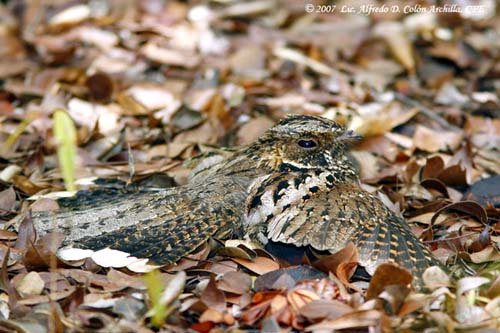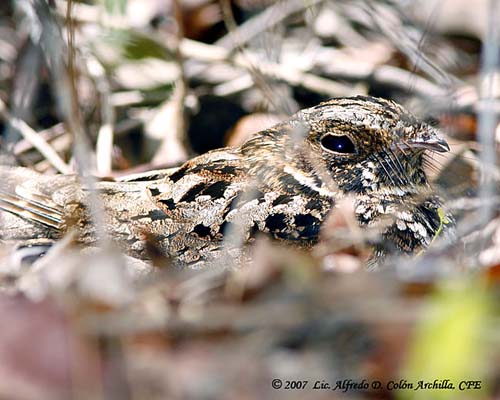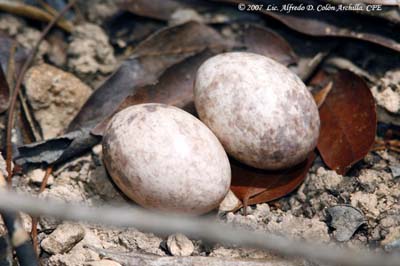
Puerto Rican Nightjar
Antrostomus noctitherus
Caprimulgiforme Order – Caprimulgidae Family
BIOMETRICS:
Length: 22-23 cm
Weight: 35-37 g
DESCRIPTION:
Puerto Rican Nightjar is endemic to Puerto Rico. Rarely seen during the daylight hours, this bird is active after dark.
Adult male has very cryptic plumage. Upperparts are grey and brown, washed rufous and streaked blackish-brown. Nape shows indistinct tawny-buff collar.
On the upperwing, coverts are greyish-brown with buff, brownish and pale greyish spots and speckles. We can see a row made of large black spots across the upper forewing and along scapulars.
Underparts are brownish, heavily spotted pale greyish and cinnamon. Belly and flanks are buff with brown bars.
The lower throat shows white or buffy-white band.
The three outer rectrices are broadly tipped-white.
On the head, plumage is cryptic too, with broad streaks on the crown. Around the base of the bill, we can see long brown rictal bristles.
Bill is blackish. Eyes are dark brown. Short legs and feet are blackish-brown.
Actually, there is no nest, only a small area where the female lays 1-2 buffy-brown eggs with darker spots and blotches.
Incubation lasts about 18-21 days, by both parents. The male incubates mainly by day. The chicks are semi-precocial and covered in rufous or cinnamon down. They are usually brooded by the male.
The young are able to fly short distances two weeks after hatching.
If nest and young are threatened, adults perform the “broken-wing” display, in order to divert the predator from the nest-site.
This species may produce one or two broods per season.
DIET:
Puerto Rican Nightjar feeds mainly on insects such as beetles and moths, and various other species. It performs flycatching sallies from perch, and pursues the prey in short acrobatic flight.
PROTECTION / THREATS / STATUS:
Puerto Rican Nightjar is classified as Critically Endangered, due to the very restricted range and deforestation. Feral cats and introduced mongooses are potential predators of the species.
The species could be present in the south-east of Puerto Rico, with occupation of abandoned secondary dry forests. Thanks to these results, the Puerto Rican Nightjar could be reclassified as Endangered.
Fr : Engoulevent de Porto Rico
Porto Rico : Guabairo
All: Puerto-Rico-Nachtschwalbe
Esp: Chotacabras Portorriqueño
Ital: Succiacapre di Portorico
Nd: Puertoricaanse Whip-poorwill
Russe: Пуэрториканский козодой
Photographs by Alfredo Colón
Puerto Rico Wildlife
Text by Nicole Bouglouan
Sources :
HANDBOOK OF THE BIRDS OF THE WORLD Vol 5 by Josep del Hoyo-Andrew Elliott-Jordi Sargatal - Lynx Edicions - ISBN: 8487334253
BirdLife International (BirdLife International)

Both sexes are almost similar. Female has narrow buffy-white tips on outer rectrices.
Immature is paler and duller than adults.
VOICE: SOUNDS BY XENO-CANTO
The male utters rapid series of whistles “whip whip whip…” of 2 to 15 notes, often starting with faint “quert” or “gaw” sounds. It also may give clucking and guttural calls.
The male can sing for several minutes. It sings from perch at night.
During the threat displays, or in defence, it gives some guttural hissing sounds.
HABITAT:
Puerto Rican Nightjar frequents semi-deciduous forests with little or no vegetation on the forest-floor. It is more abundant in dry forest with closed canopy and limestone soils.
It favours forests with hard wood trees and thick leaf-litter. It can be seen from 75 to 230 metres of elevation.
RANGE:
Puerto Rican Nightjar is now restricted to the south-west of Puerto Rico (Susua-Maricao; Guayanilla-Peñuelas; Guánica-Bermeja). It is also found in Virgin Islands.
BEHAVIOUR:
Puerto Rican Nightjar feeds mainly on various insects. The bird forages by flycatching sallies from perch beneath the canopy. It consumes the small preys while flying, but it carries the largest preys in the bill and returns to the perch. These large preys are shaken before swallowed.
Puerto Rican Nightjar also catches insects attracted to artificial light, while flying through the swarms with open gape. It also may land on the ground to pick up other insects’ species such as beetles.
Puerto Rican Nightjar is sedentary in Puerto Rico, and may be territorial with strong site fidelity.
Nightjars often rest and sleep during the daylight time. The cryptic plumage makes them almost invisible on the leaf-litter. If the bird is threatened, it flattens itself and closes the eyes to increase the camouflage, while remaining acutely alert.

The breeding season starts when the male establishes the territory by singing from different perches. Then, it strongly defends the area, mainly before the formation of the pair-bonds.
The threat displays shows the male in aggressive posture with dropped wings and fanned or raised tail, while singing loudly.
Sometimes, physical contact occurs between two males in flight, using wings and bill for fighting. Both birds often fall to the ground before to separate and go their own ways.
FLIGHT:
Puerto Rican Nightjar performs flycatching for catching preys. Usually, nightjars are good fliers, thanks to the slender, pointed wings and the fairly long tail. It is very agile in the air.
REPRODUCTION:
Breeding season occurs between late February and July, mainly from April to June.
Puerto Rican Nightjar nests on the ground, among vegetation or at base of small tree. The nest is often partially shaded and situated in woodlands.
